Some of the most atypical spiders in the world are pink. While vivid pink colors are rare in spiders, there are many species with dark pink or very bright pink around the world.
Some other types of pink nuances include salmon-pink, or pink-purple, mostly common on peacock spiders.
Tarantulas also often come with pink nuances. From pink hairs to pink stripes, there are many types of patterns this color is seen on tropical tarantulas.
Pink nuances may be differentiated by the sexes of spiders as well. Males and females often come in different colors, some include pink.
The following spider species are some of the most common spiders to come with at least partial pink coloring.
Table of Contents
1. Pink Crab Spider
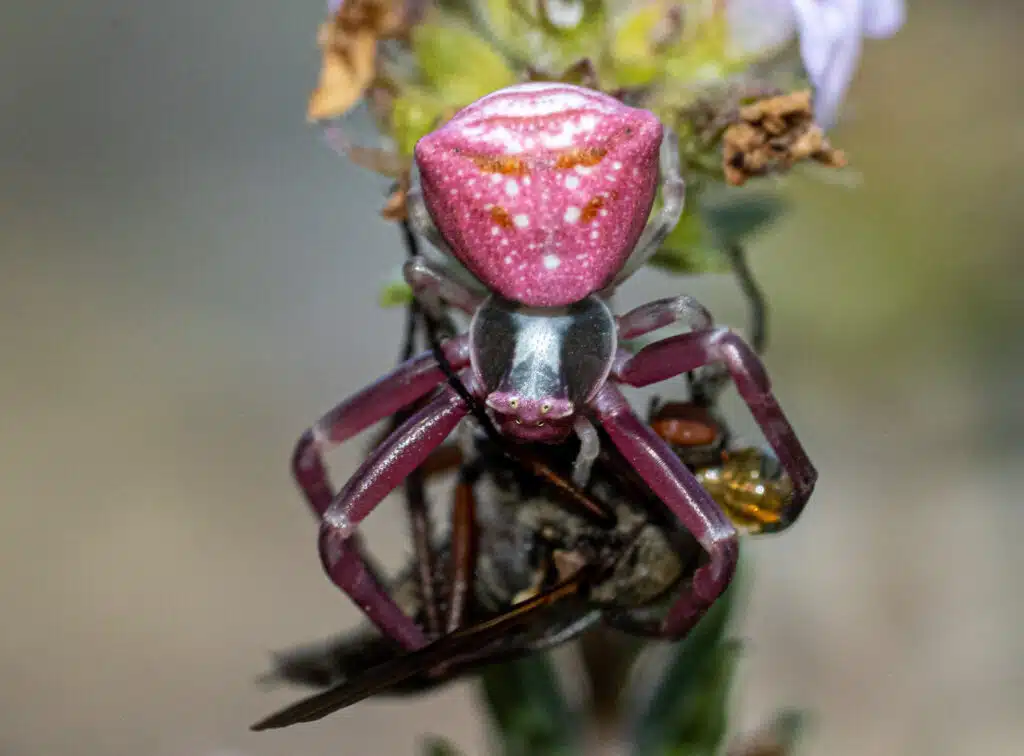
Some spiders in the world can change colors. This is the case of Pink Crab Spiders (Thomisus onustus), some of the most camouflaging types of spiders native to Asia.
Males are yellow or green but female Pink Crab Spiders can change colors. They don’t just change their appearance for no reason.
Females of the species adapt their colors to the color of the flower or plant they live on so that insects they feed on don’t easily spot them.
There’s a limited number of colors the female can take on, however. This includes purple and green nuances matching the nuances of their host flowers.
The color adaptation process begins once the female arrives at the destination flower. Once here, it can take several days for the color change process to complete.
Apart from having the capacity to change colors, female Pink Crab Spiders are large and stronger than males.
They can even catch flower-visiting butterflies and moths as a result.
Pink nuances – dark pink, bright pink, pink-purple
2. Brazilian Salmon Pink Tarantula
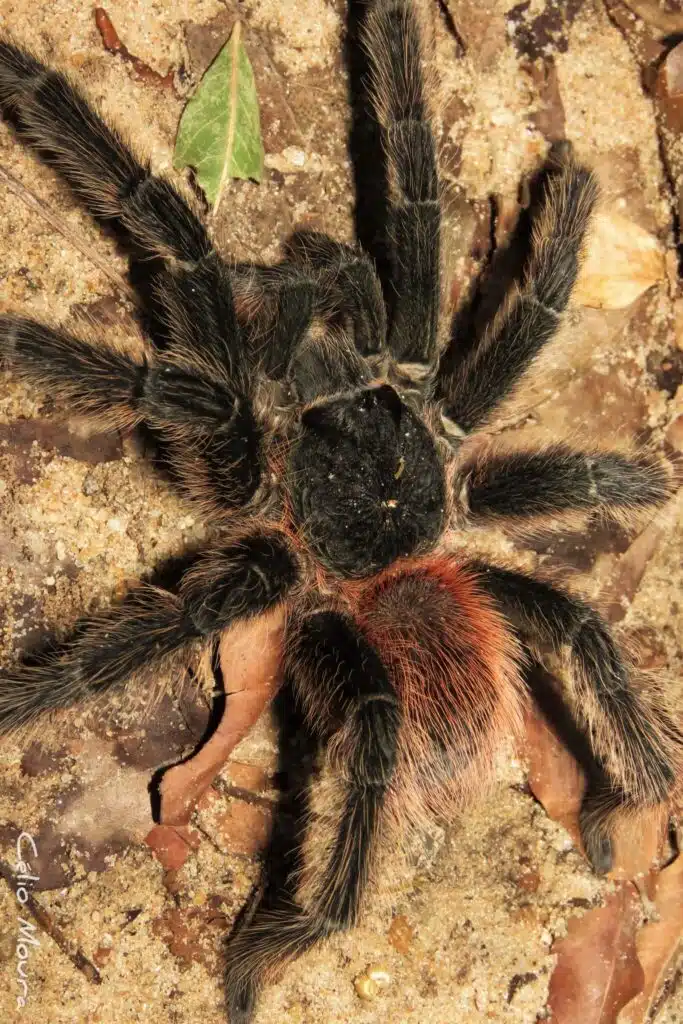
Highly common in captivity but native to Paraiba state in Brazil, this (Lasiodora parahybana) is one of the larger pink tarantulas in the world.
Growing to a size of around 11 inches, Brazilian Salmon Pink Tarantulas are mostly black at first but show pink hairs as they reach sexual maturity.
These tarantulas can also show salmon-pink hairs along their black legs.
This makes them highly attractive and a common sight among those who like pet tarantulas.
Handling these tarantulas with bare hands isn’t the best idea.
Brazilian Salmon Pink Tarantulas use their coarse hairs on their abdomen to protect themselves. These hairs can also cause mild allergic-like reactions in humans.
Pink nuances – pink, salmon-pink
3. Purple Gold Jumping Spider
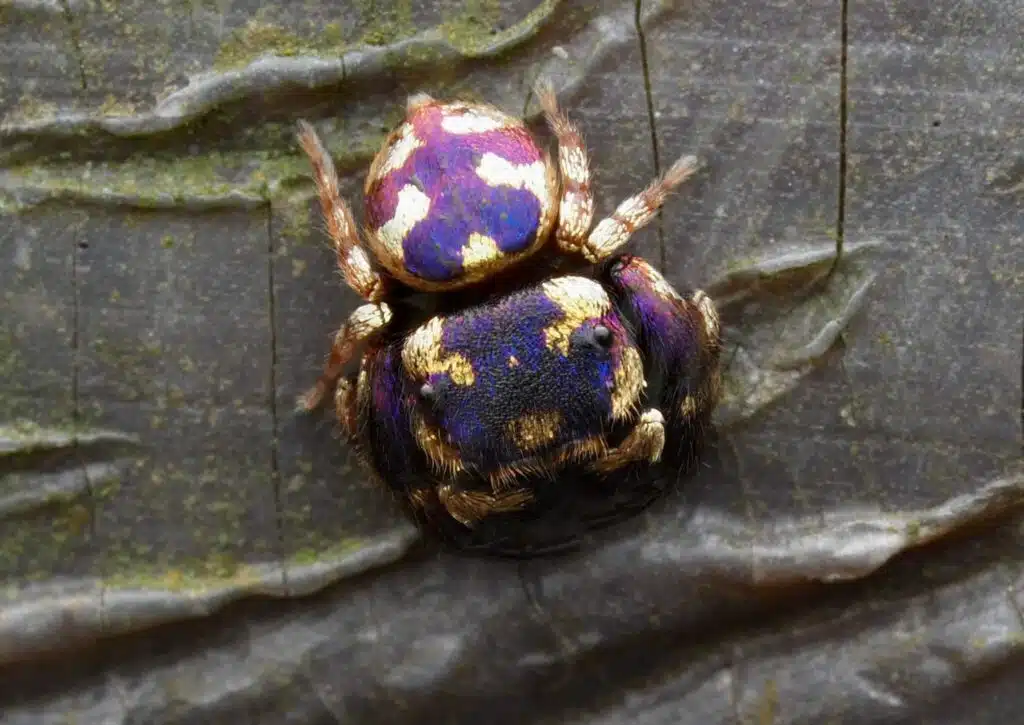
This tiny spider (Irura bidenticulate) comes in pink, magenta, and purple nuances, together with golden colors.
Just recently discovered in China and nearby countries, this is a species that may have a dark pink or dark magenta nuance, especially in the case of males.
The male of the species shows this color across its cephalothorax as well as across the abdomen.
While still very colorful, the female of the species only shows golden nuances with dark brown or black contrasting spots across the abdomen.
Much of the lives of these spiders were unknown just until recently.
Catching one should not be that difficult, despite them jumping to escape potential threats.
These spiders only grow to a maximum size of just over 0.2 inches, not being able to jump very far.
While golden nuances on the species make it stand out, it turns out Purple Gold Jumping Spiders have different golden nuances on the head.
These patterns differ from one individual to another.
Pink nuances – dark pink, pink-magenta
4. Metallic Crab Spider

A large species of spider by the length of its legs, Metallic Crab Spiders (Philodromus marxi) have a magenta or pink-magenta metallic color.
The cephalothorax is lighter, but also metallic. This is a species that additionally features golden overlays which make the spider stand out further during the day.
Its long legs aren’t pink, magenta, or even purple. Its long legs are brown and help the species move fast.
Metallic Crab Spiders have strong legs that help them climb various surfaces such as plants.
This species that’s found in grassland and next to woodlands does have coloring differences, on the other hand.
It’s only the male Metallic Crab Spiders that are pink or purple as these types of spiders have gray or almost white females.
Pink nuances – dark pink, pink-to-purple
5. Beautiful Ornamented Jumping Spider
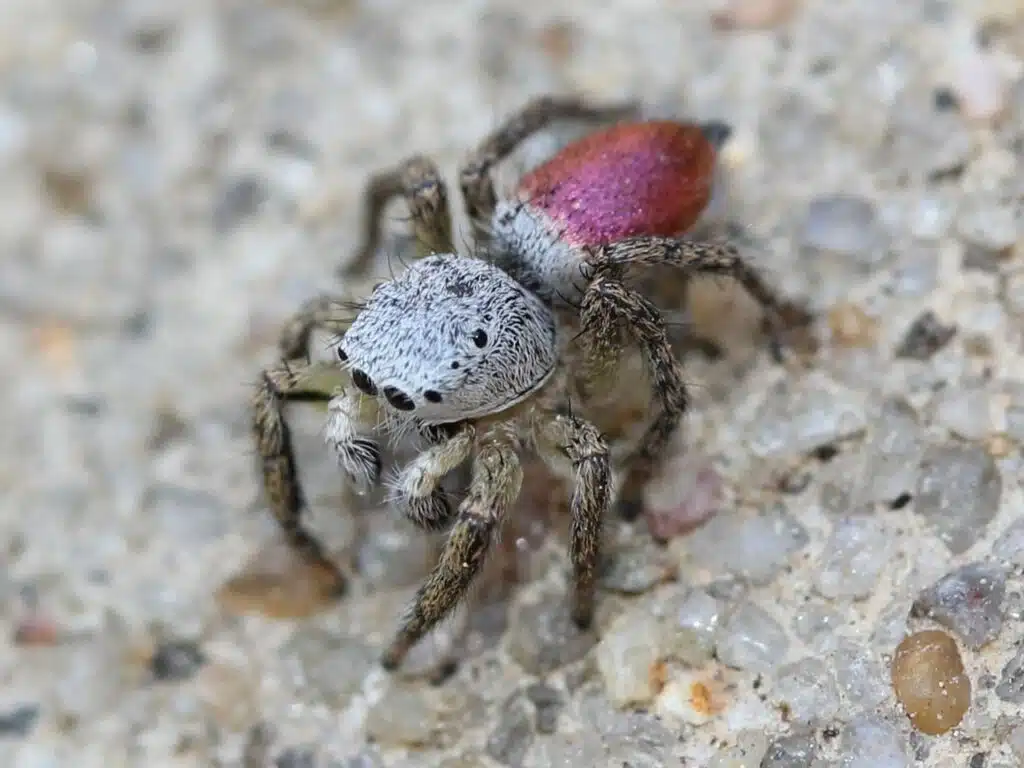
Not many pink spiders are fully pink. Beautiful Ornamented Jumping Spiders (Habronattus decorus) are partially pink.
They have a dark pink abdomen, a black cephalothorax, and black matching legs.
Native to North America, this type of jumping spider also has a metallic nuance to its pink abdomen, which can also be brown-pink, or pink-red with iridescence.
Actual pink nuances on the abdomen of The Beautiful Ornamented Jumping Spiders vary by region as well.
This is a widespread species from the Southeastern US regions to Eastern Canada with multiple pink nuances.
From dark pink to pink-purple, the abdomens of the spiders are iridescent.
A species that’s believed to be aggressive, this spider has a painful but non-venomous bite.
The species is highly common in North American woodlands where it lives together with more than 100 other Habronattus spider species.
Pink nuances – iridescent pink
6. Thin-spined Jumping Spider
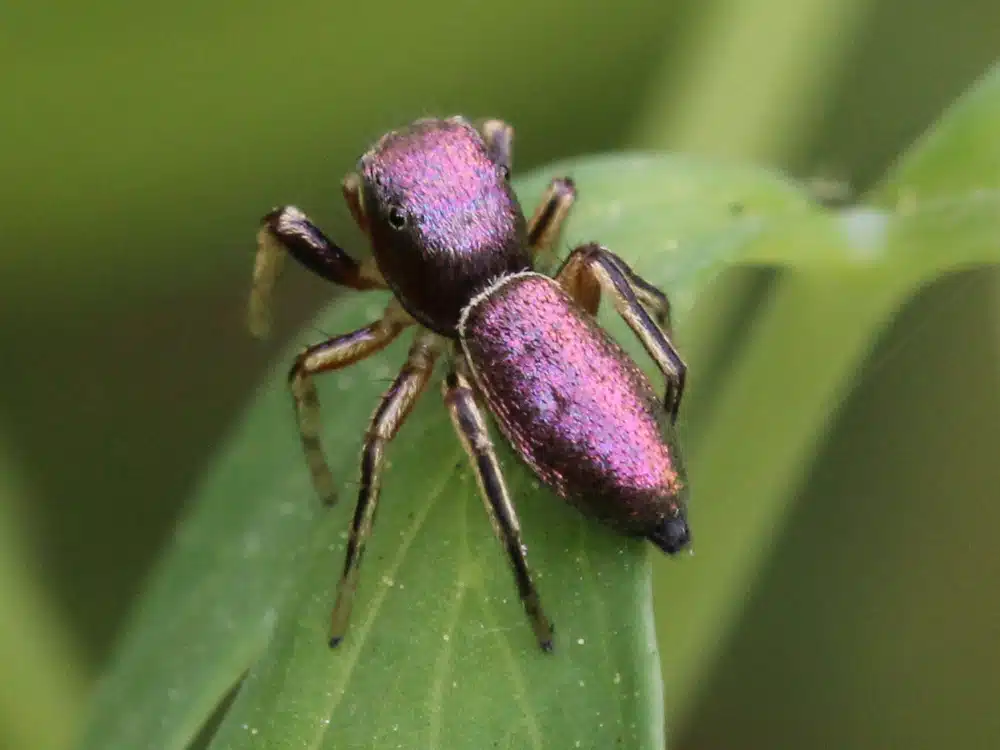
Female Thin-spined Jumping Spiders (Tutelina elegans) sometimes have pink-only abdomens and a dark cephalothorax.
They can also have entirely pink-magenta coloring, being some of the most striking spiders in Eastern North America.
There’s a fine white margin running along the abdomen that adds contrast to the metallic pink abdomen of this species.
Dark pink nuances are further seen on the legs of females.
Male Thin-spined Jumping Spiders mostly have a yellow-brown nuanced with matching brown legs.
Additional black stripes are seen on the legs of males.
Pink nuances – dark pink, pink-magenta, iridescent pink
7. Thick-spined Jumping Spider
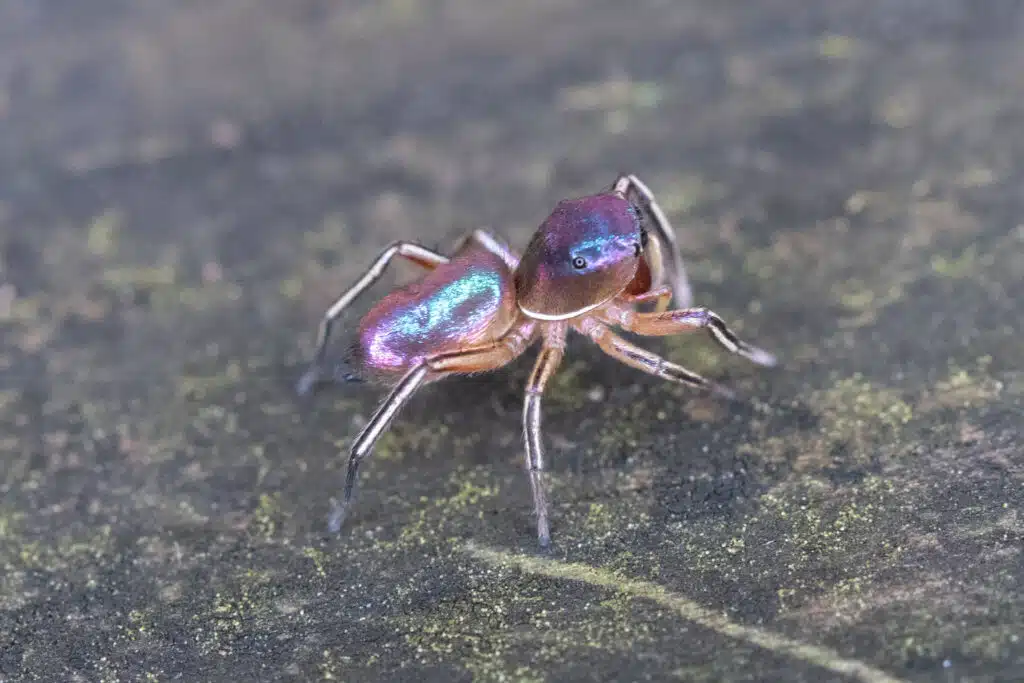
Numerous iridescent colors are seen on Thick-spined Jumping Spiders (Tutelina similis).
This is a species with a coloring difference between males and females. The female spider shows pink and pink-purple nuances on the sides of the abdomen and the sides of the cephalothorax.
Dominant colors across the body include iridescent green and yellow.
Males are less colorful. They show brown body nuances with additional white hairs that add contrast to their darker appearance.
Pink nuances – pink-purple
8. Peacock Spiders
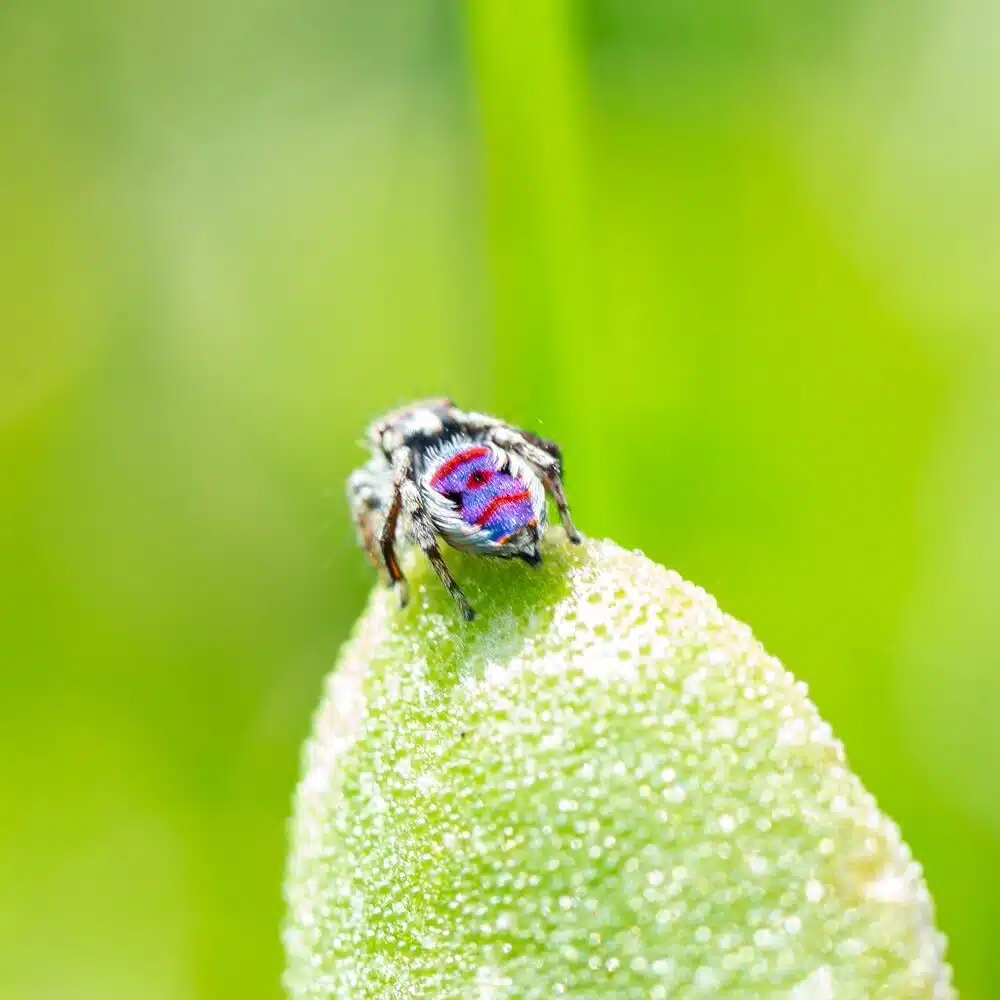
Some of the most colorful spiders of Australia with pink nuances are those of the Peacock genus (genus Maratus).
These types of spiders are known for their vibrant colors in hundreds of different shades of red, blue, and pink.
It’s estimated there are almost 600 species of Peacock spiders in Australia alone. Many of them are yet to be documented.
Some of the smallest pink spiders in the world. Peacock spiders are known for their complex breeding rituals where males communicated with females by producing ground vibrations.
Banksia Peacock Spiders (Maratus mungaich) is an example species with pink nuances. Their iridescent abdomens can be dark pink or pink-purple.
Pink nuances – bright pink, dark pink, iridescent pink, blue-pink, pink-purple
9. Ecuadorian Red Bloom Tarantula
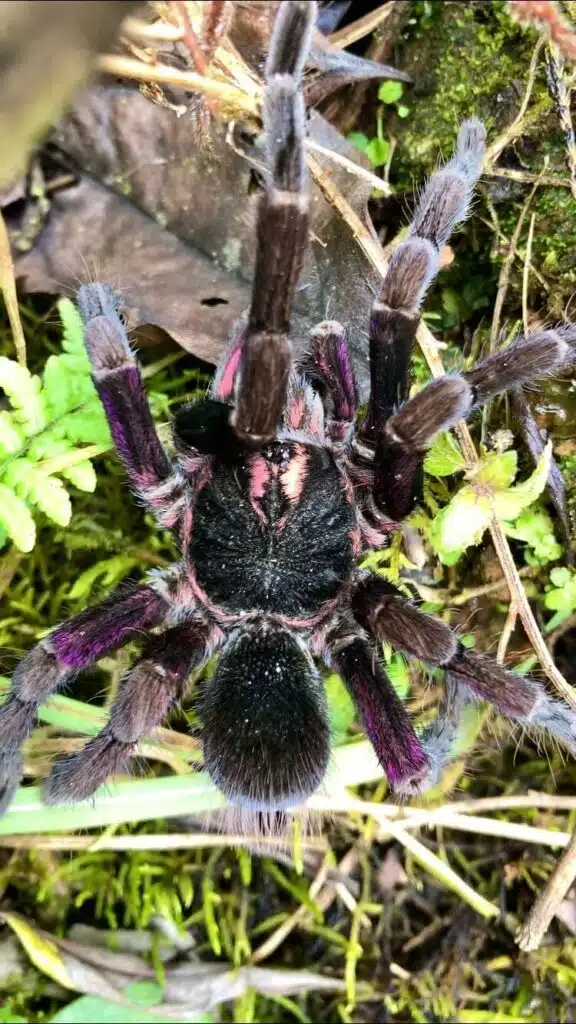
An Ecuadorian native, this species of tarantula (Pamphobeteus vespertinus) also comes in a dark pink morph.
The species is mostly black, showing pink sections in the form of stripes on its cephalothorax while its abdomen has uniform black coloring.
Pink and pink-purple nuances are specific to the legs of the species. This is a tarantula with a combination of black and pink sections on its hairy legs.
Ecuadorian Red Brown Tarantulas also come in red-brown abdomen coloring but aren’t as popular in the capacity of other tarantulas.
They are considered aggressive and not the best first choice for collectors.
Pink nuances – dark pink, pink-purple
10. Antilles Pinktoe Tarantula
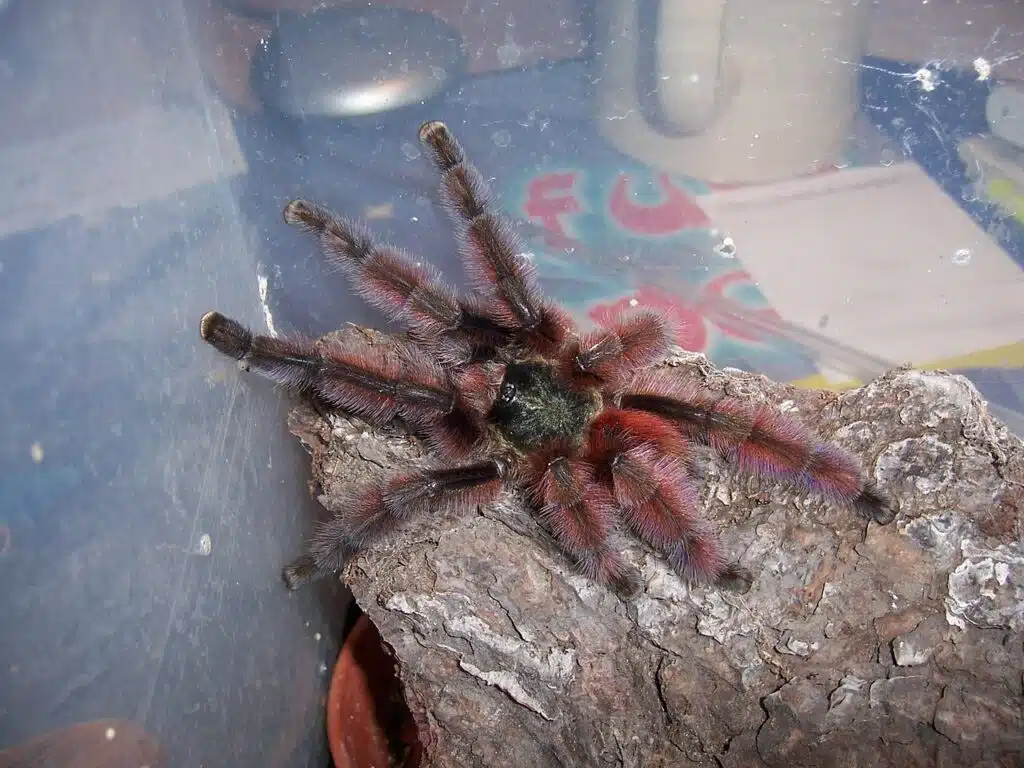
An Antilles and Martinique native, this type of tarantula (Caribena versicolor) is known for its multicolored appearance.
Pink and pink-red nuances are specific to the hairs on its abdomen. This is a species that may additionally show pink hairs on its legs, albeit scarce compared to its dominant black hairs.
The cephalothorax of the species also has a specific iridescent green nuance.
However, Antilles Pinktoe Tarantulas don’t always have these colors as they are mostly dark blue in their early days.
It’s only as they age that they slowly progress towards black, pink, and iridescent green nuances.
Mostly common captivity for its vivid colors, The Antilles Pinktoe Tarantula is fed all types of bugs.
Pink nuances – pink, pink-red
11. Amazonian Pinktoe Spider
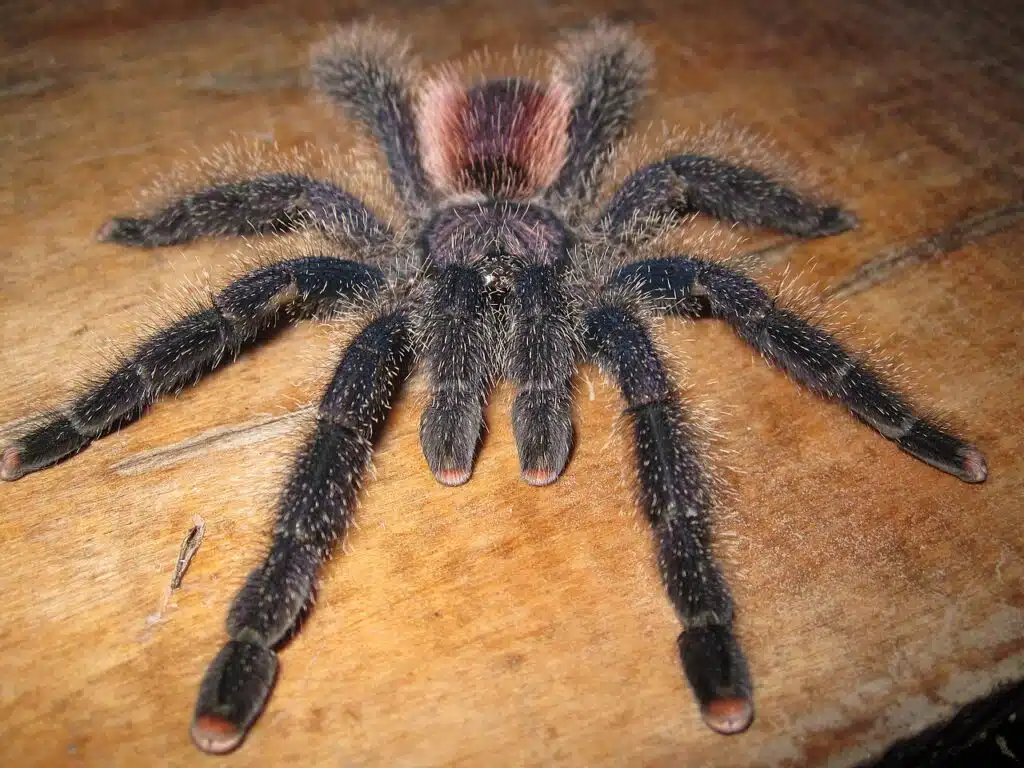
A species of The Amazon, this type of tarantula (Avicularia juruensis) is named after the pink nuance of the legs of its females.
Additional pink sections are further distinguishable on the sides of its abdomen.
Females Amazonian Pinktoe Spider is further known for its blue-red cephalothorax.
Males of the species are typically darker. Mostly black, the male tarantulas only show blue sections across the cephalothorax.
Only the juveniles of the species are brighter. They are dominated by brown nuances and start to darken as they become adults.
Not much is known about the lives of these tarantulas in their native areas as they have expanded West towards Colombia.
Pink nuances – dark pink
12. Grizzled Pinktoe Tarantula

Named after its pink sections across the legs, The Grizzled Pinktoe Tarantula (Avicularia variegata) is a docile tarantula found in captivity, around the world.
It lives at least 10 years, which makes it a common long-term pet tarantula in enclosures.
Some coloring differences are spotted between the male and the female Grizzled Pinktoe Tarantulas.
Females of the species are slightly brighter and also show an inclination towards extra pink sections on the legs.
An actual species of the deep Amazon, Grizzled Pinktoe Tarantulas are found in some of the most humid areas of the rainforest.
Pink nuances – dark pink
13. Bromelia Tarantula
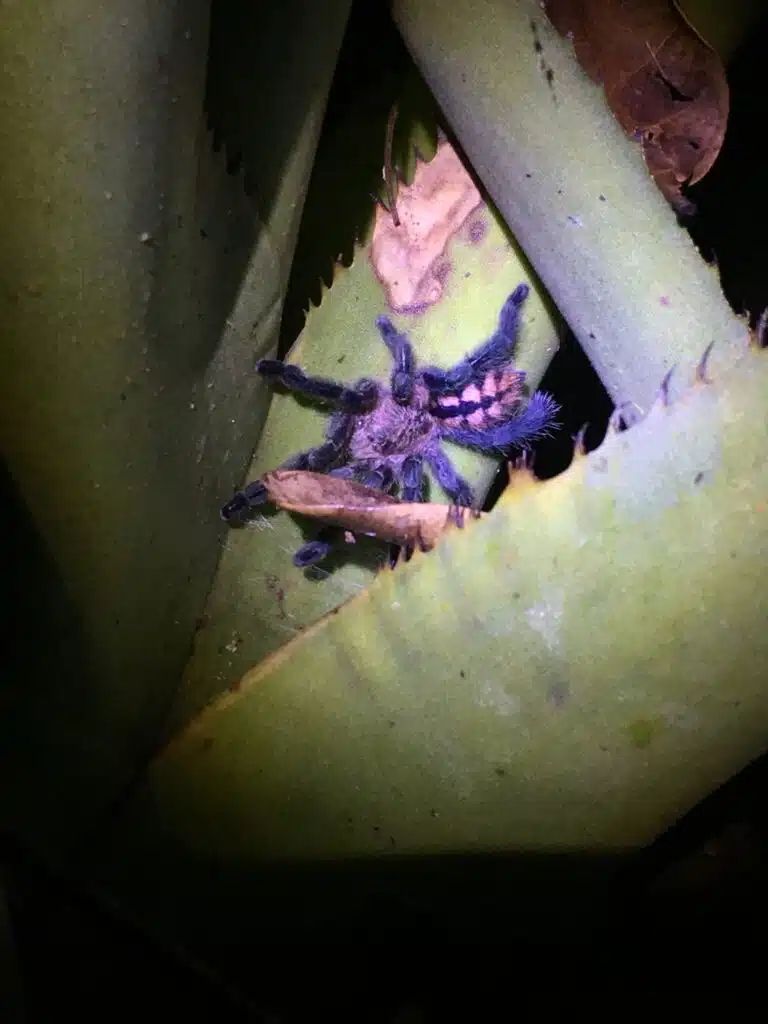
Almost completely black, The Bromelia Tarantula (Pachistopelma rufonigrum) has faded pink shades along its legs and faded brown coloring on its abdomen.
Faded pink spots are also seen on young females’ abdomens.
A pattern of 6 pink marks can be spotted on their abdomens. These triangular spots are arranged in 2 rows, on the sides of a separating central mid-dorsal blue line.
Males of the species tend to be darker. Most males are either completely black or black with hints of gray.
Juveniles of the species additionally show scarce pink hairs on the lateral cephalothorax.
As they age, these spiders start to darken.
Pink nuances – bright pink
14. Sumatran Stout Leg Tarantula

This burrowing type of tarantula (Lyrognathus giannisposatoi) is named after its Sumatran native range.
Females of the species are more colorful, while still mostly black, as males.
Pink sections are characteristic of the front legs of the females. Furthermore, there are visible pink stripes on its carapace as well.
Groups of stripes are seen at the edges of the carapace, close to the legs. This species additionally shows pink bands on its rear legs.
A highly docile type of tarantula, The Sumatran Stout Leg Tarantula can be raised in captivity as long as it has good burrowing substrate.
Pink nuances – bright pink
15. Goliath Pinkfoot Tarantula
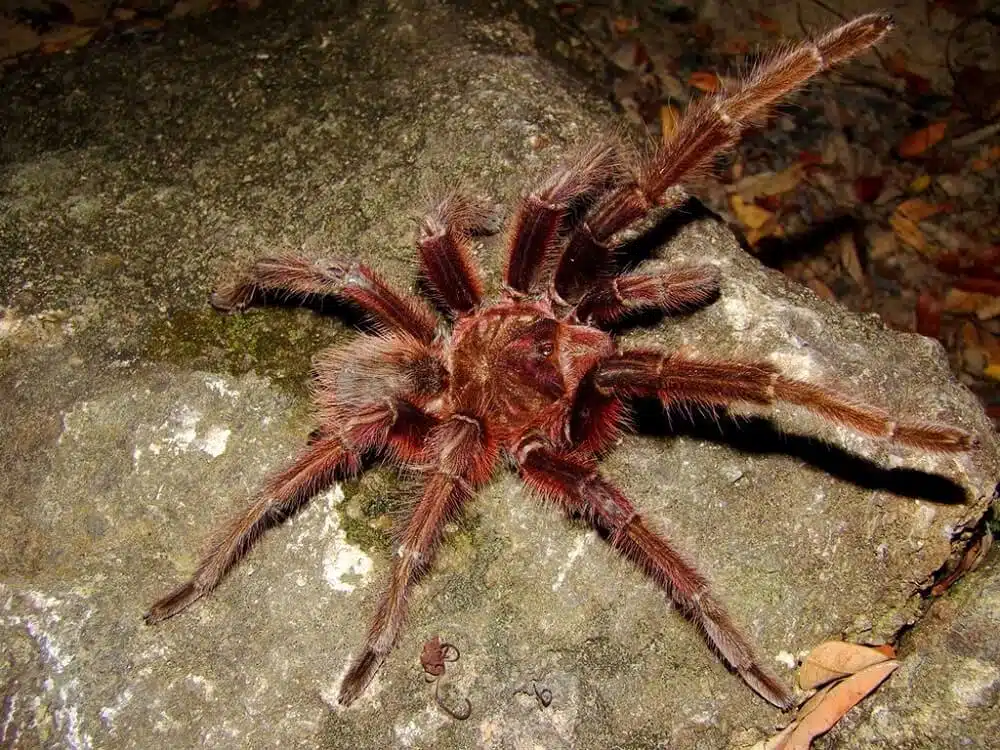
Named after their bright pink legs, these types of tarantulas (Theraphosa apophysis) show salmon-pink nuances both across the legs and the body.
Mostly black and brown, The Goliath Pinkfoot Tarantula is a species that shows additional pink-orange hairs around the carapace and the abdomen.
Salmon pink hairs also grow around its mouthparts.
While attractive by colors, Goliath Pinkfoot Tarantulas are aggressive. They often remain still for hours in a defensive posture as well.
Blue nuances are also seen on Goliath Pinkfoot Tarantulas. These blue nuances are specific to its carapace, next to the legs.
Additional blue and white hairs grow on the lower abdomen of the male.
This is why they may not be recommended in captivity, at least to those new to tarantulas. More experienced tarantula pet owners like them for their colors, very large size, and long lifespan.
Goliath Pinkfoot Tarantulas can live up to 20 years.
A Brazilian native, Goliath Pinkfoot Tarantulas are terrestrial tarantulas that live in forests.
Pink nuances – bright pink, pink-purple